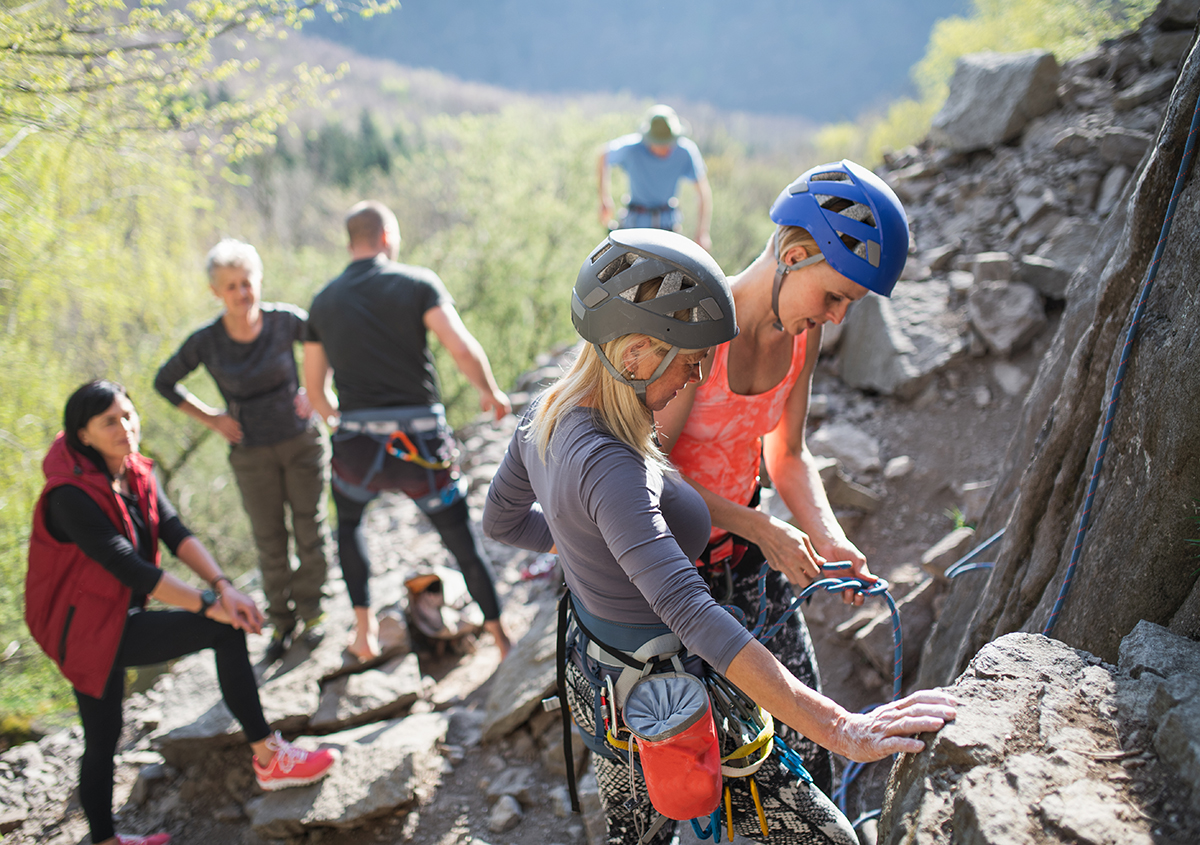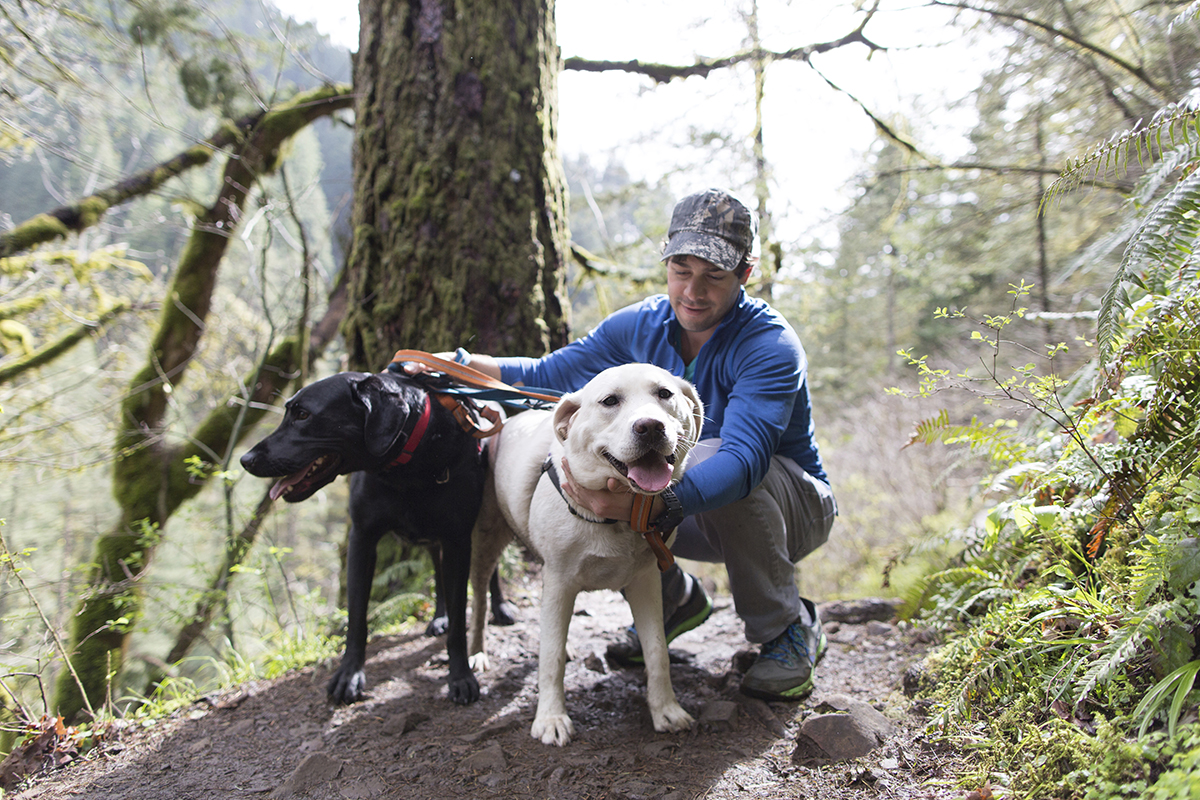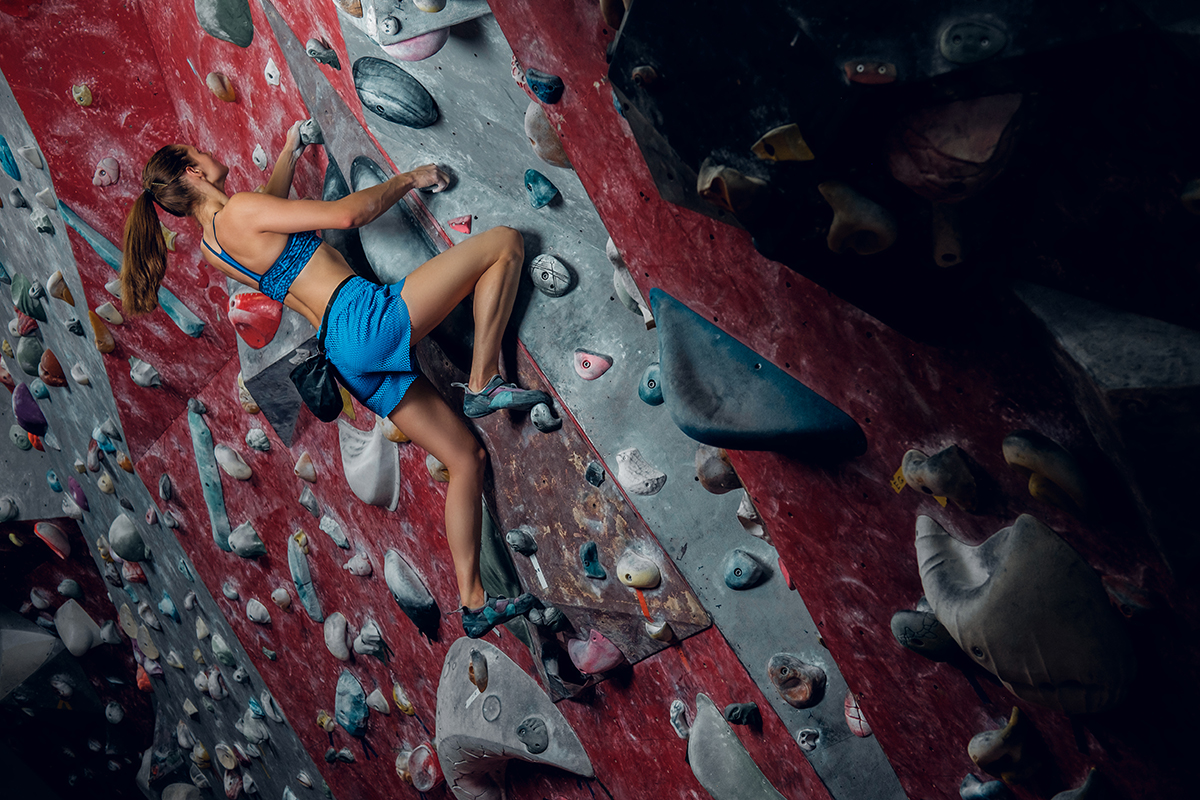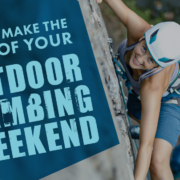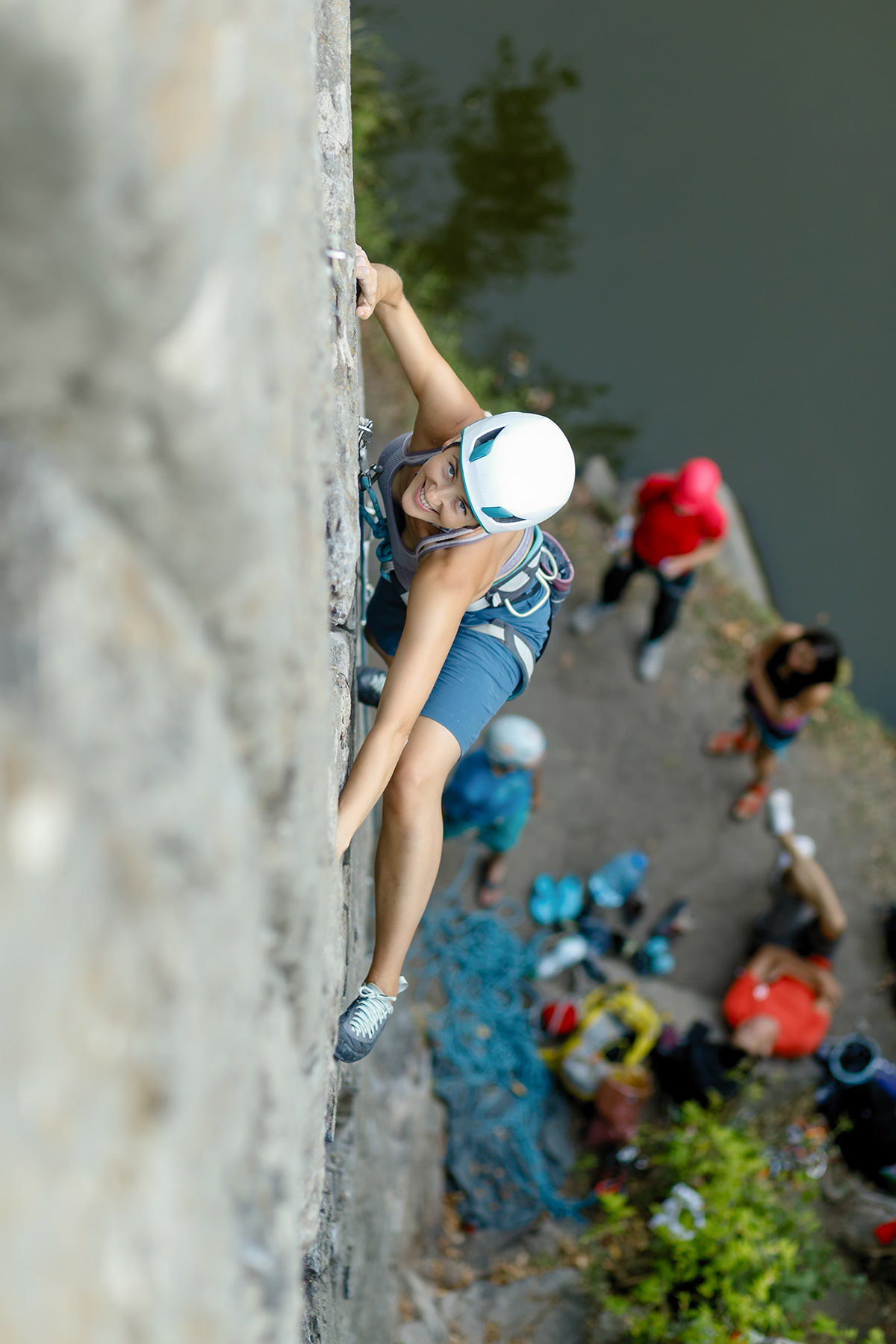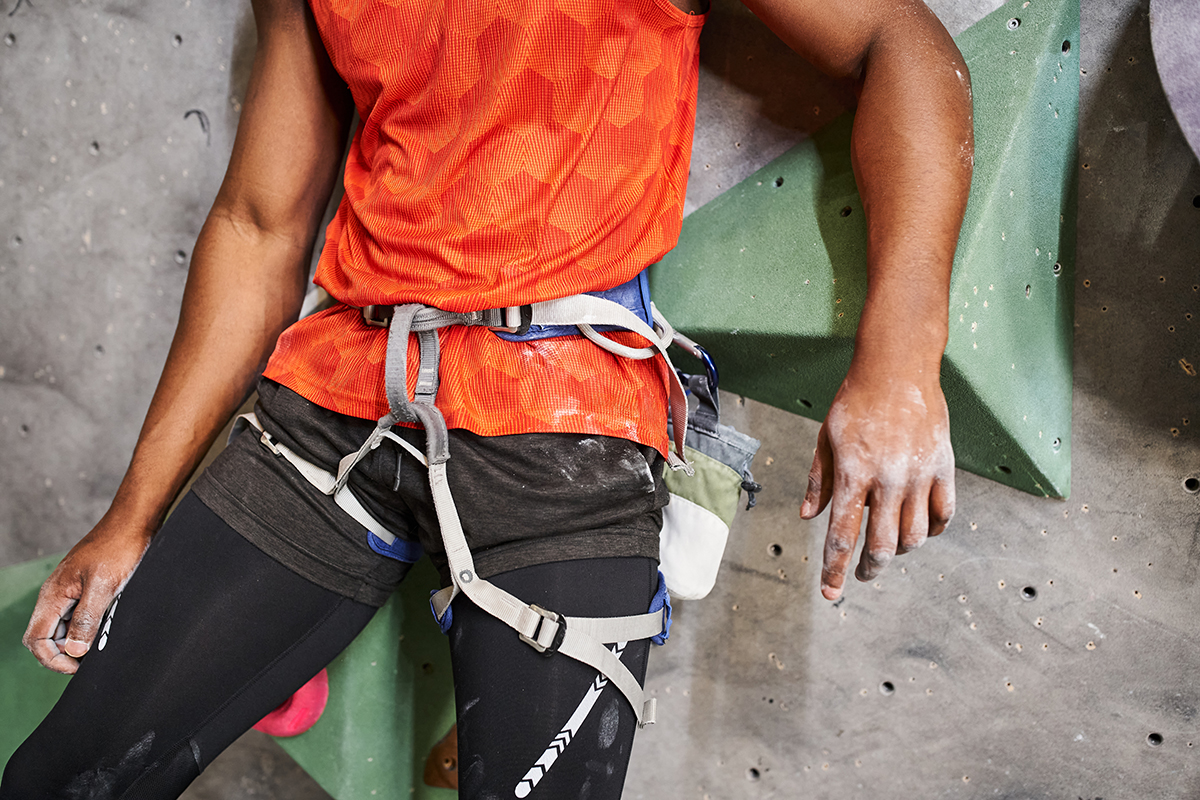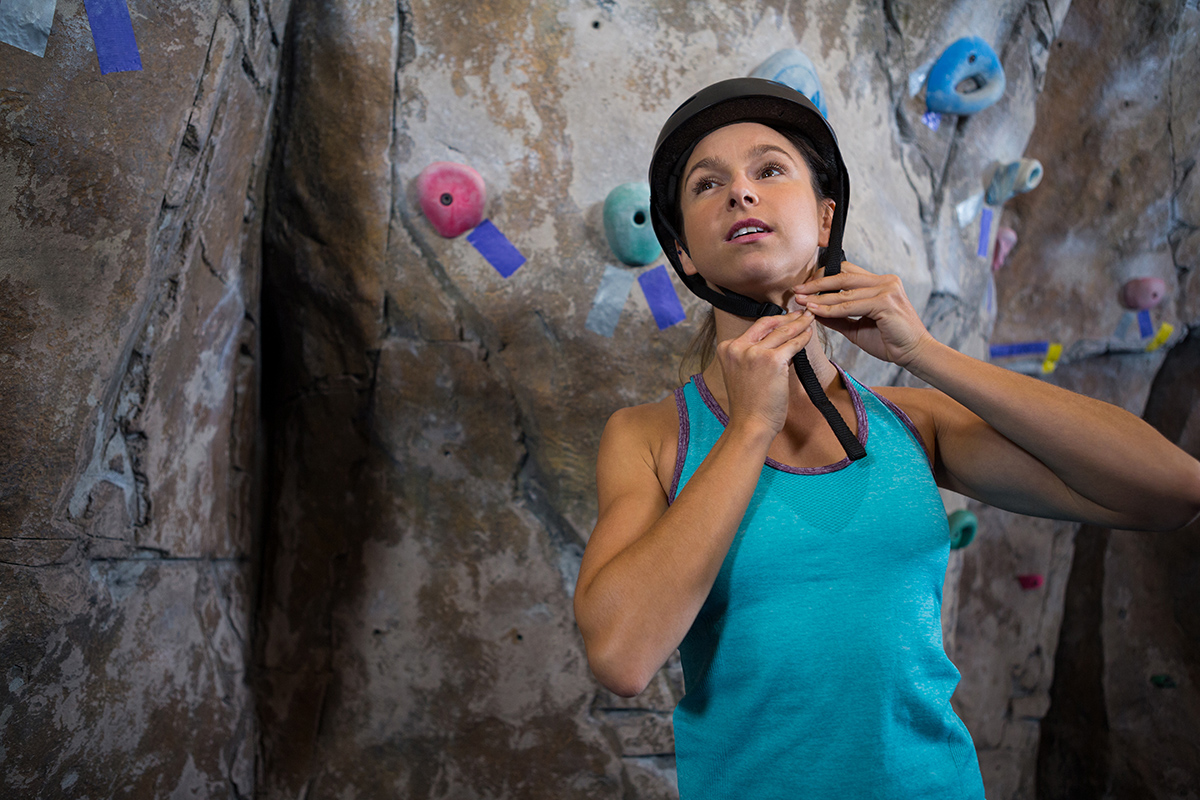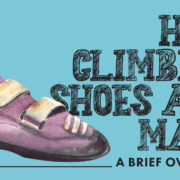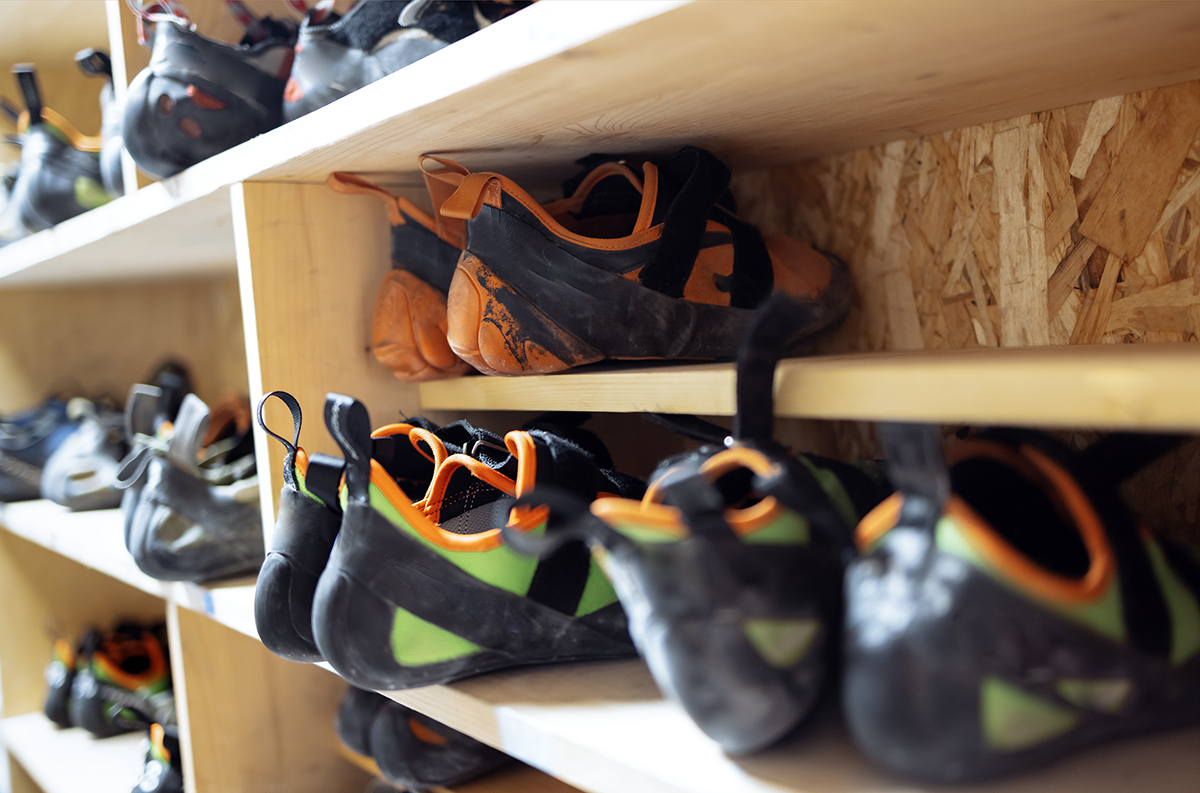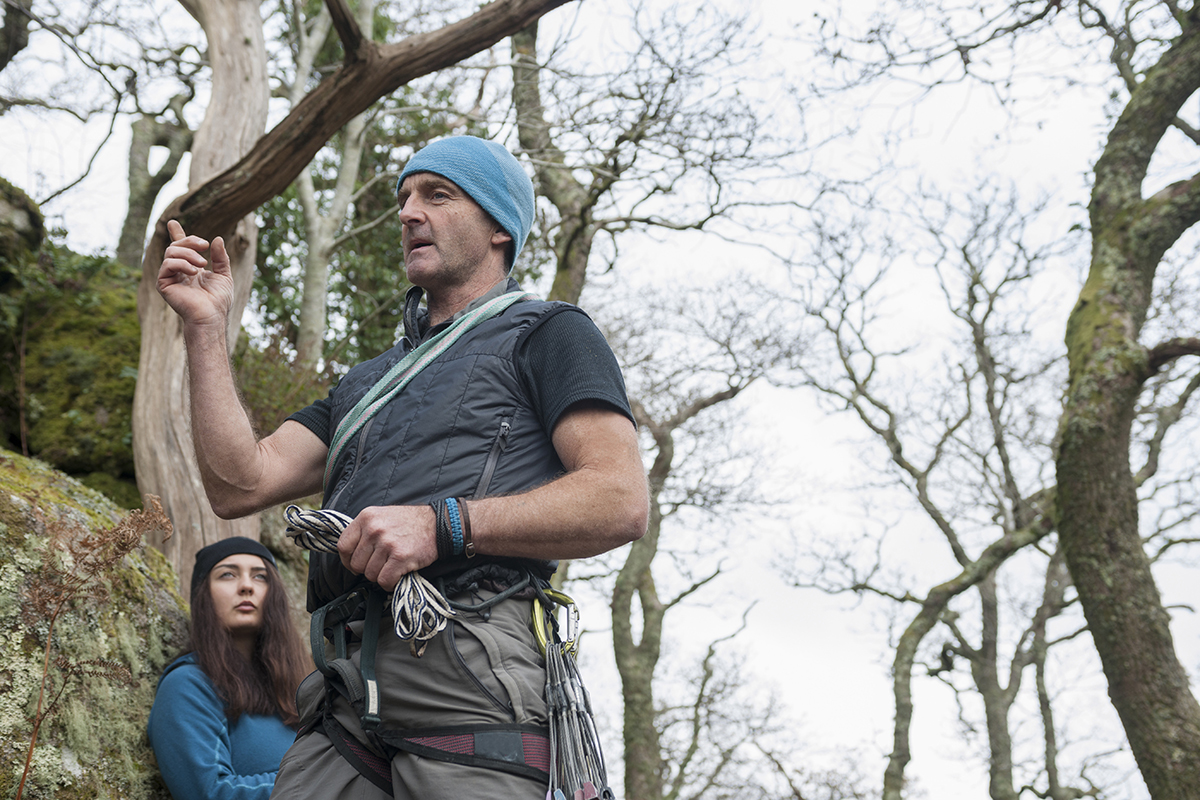
Know the Climb: Get a Guidebook
Outdoor Boulders: Highballs and Hard Moves
Sport Climbing Outside: Gear and Weather Considerations
Outdoor climbing can be both challenging and exciting, offering a rewarding experience. Spending time in nature is a relaxing and rejuvenating experience. Nothing is worse than gearing up for an outdoor climbing trip, buzzing with excitement, only to arrive at the crag and be greeted by noisy, untidy wall hoggers. Like a climbing gym with rules and etiquette to ensure an enjoyable experience for all participants, outdoor climbing has its own etiquette.
Outside, you are a guest in Mother Nature’s house. Being a respectful crag guest is vital for preserving climbing access, ensuring climbers’ safety, and contributing to the climbing community’s good-natured reputation. If you’re new to outdoor climbing and unfamiliar with the etiquette, you’ve landed on the right page. We’ve created a practical guide to help you learn how to be a respectful crag guest so you and your fellow climbers can have fun and feel welcome at the crag.
I. Research the Area Before You Go
Climbing access is a privilege, but the authorities may restrict access if you abuse it. Depending on the climbing location, climbing areas may be publicly or privately owned. Knowing land ownership and access policies (such as whether a permit, park pass, or reservations are required) will ensure you climb in designated areas. Weather, crag maintenance, or other hazards can also impact seasonal access.
Resources such as Mountain Project, local climbing organizations, guidebooks, or the government websites listed below can provide the necessary information. Remember, ignorance won’t pass as an excuse – do your research.
- National Park Service: https://www.nps.gov/aboutus/lawsandpolicies.htm
- United States Forest Service: https://www.fs.usda.gov/
- Bureau of Land Management: https://www.blm.gov/programs/recreation
II. Keep Your Volume in Check & Park Responsibly
Despite being outside, try to use an indoor voice unless communicating with a climber high up on the wall or alerting other climbers to falling objects by shouting “Rock!” Other groups don’t want to hear your conversations, nor does the wildlife. If you’re going to listen to music, consider using headphones. If you’d like to play music off a speaker, ensure it’s okay with other climbers in the area and be mindful of the volume. You’re climbing, not going to a rave.
Many climbing areas have limited parking. If you have a large group, consider carpooling. Only park in designated areas, never blocking roads, driveways, or parking on marked private property. Not only could you get ticketed or towed, but it could lead to a ban on climbing access, impact emergency vehicles, or inconvenience locals who use the road or driveway daily.
III. Leave No Trace (LNT)
Leave No Trace, Inc. was established in 1994 to expand the National Outdoor Leadership School’s (NOLS) educational curriculum. The LNT program provides science-based education structured around seven core principles to help visitors of the outdoors minimize their impact on nature.
Plan Ahead and Prepare. (See section #1 of this article for a climbing-specific explanation of this principle.)
Travel & Camp on Durable Surfaces. Stay on marked trails when hiking into and between the climbing areas. When camping, stay in designated campsites or campgrounds. Bushwacking, going off-trail, or camping in unauthorized areas can damage natural vegetation, disrupt wildlife, and put you in danger.
Dispose of Waste Properly. Pack out all your trash, including bathroom and hygiene supplies. Carry a WAG bag for a #2 emergency or use a designated toilet. If there are trash cans available, ensure that your trash is disposed of in them.
Leave What You Find. Don’t take home any climbing gear that is not yours. If there are quickdraws or carbineers left on the climbing wall, you can use them when climbing, but do not remove them. You can take pictures, but don’t take the outdoors home (i.e., leave rocks, plants, flowers, critters alone).
Minimize Campfire Impact. Wildfires can be catastrophic. Don’t let your campfire be the cause of something dangerous. Tend to any active fires and ensure they are put out properly.
Respect Wildlife. Leave the plants and animals alone. They won’t bother you if you don’t bother them. Remember, you’re a guest in their house.
Be Considerate of Others. (See section #4 of this article for a climbing-specific explanation of this principle.)
IV. Be Considerate of Other Climbers
Sometimes, you may be the only climber(s) at the crag. Other times, it’ll be bustling with fellow climbers. When climbing in a busy area, don’t monopolize the popular routes. If you want to return to a climb but need a break, you can offer to let others use your gear but avoid hangdogging (a combination of excessive resting and falling) on the wall.
When hiking to the climbing area, let faster hikers pass you. At the crag, keep your gear and bags out of the main walking path and away from the base of the wall. Try to keep your area tidy and be mindful of others’ belongings and equipment.
It’s bad practice to spray beta unless invited. Brush away any tick marks you make, but leave any tick marks you find. It’s also considerate to brush away excess chalk before you leave a climb, although this may only be feasible on boulders.
V. Be Dog-Responsible (if bringing a furry friend)
Fur friends are awesome, but only bring them if you know they will be well-behaved. Otherwise, leave them at home for their safety and the sanity of other climbers. Check the local rules and regulations before letting a pet off-leash. Always pick up their waste and pack it out. If allowing them off-leash, be mindful that not everyone at the crag loves dogs and respect others’ requests.
VI. Follow Rules, Regulations, and Local Ethics
Outdoor climbing has ethics and unofficial rules. For example, respect the first come, first serve rule. Don’t dilly dally before climbing or be a wall hog, but if you arrive at the climb first, you have the right away.
Another frowned-upon practice is using anthropogenic materials such as glue or drills to fix cracked holds or create pockets. There are often written local rules and regulations around bolting new climbs. There may also be a history of local climbing to respect. Ensure you know what rules are in place and if there are any local climbing traditions.
Recapping: How to Be a Respectful Crag Guest
A respectful crag guest is considerate of Mother Nature and other climbers. They take responsibility for the items they bring to the crag and how they treat the land. A respectful crag guest comes prepared, having researched the area, rules, regulations, and local ethics beforehand. At the crag, they are respectful of other climbers, sharing the outdoor space. When it’s time to leave, they hike out on designated trails, dispose of trash in designated receptacles, and take photos, not souvenirs. As an outdoor climber, you accept the responsibility of being a good steward of our lands for other people and future generations to enjoy. Don’t be afraid to politely say something if you see something, and choose to lead by example. Enjoy your outdoor climbing adventures!
It’s fascinating to realize that climbing has been a sport since before women had the right to vote in the United States. Women have been instrumental in shaping the sport’s development since its inception, and their impact continues to grow. The future of climbing, both as an indoor competitive sport and an outdoor adventure sport, is significantly influenced by the current landscape of female competitors. Here are four ways women today are shaping the future of climbing.
1. Women Are Dominating
Highly popular sports have nearly always been associated with dominant, phenomenal athletes; basketball has Lebron James and Michael Jordan, and football has Tom Brady and Jerry Rice. The popularity and fandom of a sport generally come on the heels of larger-than-life athletes who outperform, outscore, and completely dominate their competition consistently. It has become clear to anyone even moderately paying attention to women’s climbing that Janja Garnbret is the world’s most prolific, predominant female climber. Arguably, her fame became legendary during the 2019 World Cup season, when she won every event, sweeping all six World Bouldering Cups. While an entire article could be written on her successes alone, it is crucial to understand what a dominating figure does for the sport of climbing. Janja, in her accomplishments, is helping solidify the future of climbing as a popular, entertaining sport with an excited and populous fandom.
Janja’s fame generates interest and buzz around the sport, and her dominance also catalyzes all other athletes’ performance. Her achievements drive the intensity of competition and push the limits of what is thought possible in climbing. In this regard, climbing can be compared to the sport of running. For centuries, it was believed that running a mile in under four minutes was physically impossible until Roger Bannister shattered that barrier in 1954. His success inspired other athletes to achieve the seemingly impossible and break the four-minute barrier. Janja is the Roger Bannister of competitive climbing, showing how to achieve the previously thought impossible and paving the way for other athletes to follow her into greatness.
2. Women Are Ascending
First ascents (FAs) and high-grade sends have consistently seen more women ticking off said achievement. Isabelle Faus began an impressive FA streak in 2022, posting the first female ascent of Shadow Walker (V14/8B+), and following quickly in 2023 with The Grinch (V13/8B) and Spidey (V14/8B+), and in 2024 with Mirta (V14/8B+). Laura Rogora, focusing on ropes, posted ascents including Lapsus (9a+/5.15a) in 2023, and Goldrake (9a+/5.15a) and Trofeo dell’Adriatico (9a+/5.15a) in 2024. In 2024, Oraine Bertone completed Soudain Seul (V16/8C+), becoming the first woman to send this grade, which is only one grade below her male counterparts. These women are not just establishing themselves in climbing. They are setting new records and pushing the boundaries of what is possible in the sport, proving that climbing is not just a male-dominated field.
3. Women Are Closing The Gap
Despite climbing being historically a majority male space, the tide is turning. Women are increasingly joining climbing gyms, becoming commercial setters, and coaching competitively. In 2019, the ACC found that 42% of indoor climbers were female, a significant increase from previous years. While the data is not readily available, it is estimated that roughly 1 in 3 coaches and 1 in 5 setters are female. The sport is evolving as more women join gyms, climb, coach, and set. Climbing, already considered a collaborative and community-driven sport, is on the brink of a significant cultural shift. Female participation is set to change the gym’s culture, the coaching of athletes, and the climbs set for all to enjoy, inevitably shaping the future of climbing.
You have time off from work, your friends have all booked a campsite or Airbnb, and you chose a great climbing area for your outdoor climbing weekend. No more fighting for space in the crowded gym during peak hours on the weekend. Instead, you’ll fight for your turn on the classics.
Discover why meticulous planning and a flexible mindset are crucial to making the most of your outdoor climbing weekend!
Researching The Best Climbing Areas Nearby
Selecting the right climbing destination begins with considering what’s closest to you and your skill level. Are you a beginner looking for well-bolted sport routes with easy access? Or are you a seasoned trad climber seeking multi-pitch adventures in remote areas? Regardless of your skill level, if you’re lucky enough to have options for weekend getaways, then you should use something like Mountain Project to help you decide where to go.
Timing is a critical factor in climbing. A route that’s perfect in spring could be scorching in summer or dangerously icy in winter. Research historical weather patterns, local climate reports, and recent trip reports from other climbers to stay informed before you go.
Popular climbing destinations can get crowded, especially on weekends and holidays. However, with the proper research, you can find less-traveled crags that offer equally rewarding climbs without the crowds, providing a more exclusive and adventurous experience.
Gear and Essentials You Can’t Forget
A successful climbing trip starts with reliable gear; make sure you don’t forget anything. Essentials include a harness, climbing shoes, a helmet, and a belay device. You’ll also want a rope. Depending on your style of climbing, you’ll either need quickdraws or trad gear.
Layering is key when climbing outdoors. Moisture-wicking base layers, an insulating mid-layer for warmth, and a durable, weather-resistant outer shell are excellent components for a well-rounded dressing.
Consider wearing sun protection, such as hats and UV-blocking shirts, when exposed to the sun. If you don’t think you’ll use them, pack gloves and a beanie for chilly belays. They’re small and easy to stuff into a climbing pack. Always prepare for unexpected weather shifts, even if the forecast looks stable.
You can’t forget the snacks! Pack nutrient-dense foods, such as nuts, jerky, energy bars, and fresh fruit. Lightweight dehydrated meals are a convenient option for longer trips in the backcountry.
Hydration. Hydration. Hydration. Carry enough water or a filtration system if natural sources are available. Electrolyte supplements can help maintain energy levels and prevent dehydration.
A well-stocked first aid kit is a non-negotiable part of any climbing trip. Include essentials like bandages, antiseptic wipes, blister pads, and pain relievers. A compact emergency blanket, whistle, and multi-tool can be lifesavers in unexpected situations. Consider carrying a personal locator beacon (PLB) if venturing into remote areas with limited cell service.
Making Your Basecamp Comfortable
If you opt for the camping option, you’ll know that a well-chosen campsite can significantly enhance your climbing experience. Look for flat ground, natural wind protection, and proximity to water sources, whether that’s a stream or a nearby water source.
A high-quality tent, warm sleeping bag (unless it’s unbearably hot where you’re going), and comfortable sleeping pad are must-haves for a good night’s rest. A lightweight stove, cooking utensils, and a headlamp make camp life more manageable when you only want to relax at the end of a long climbing day.
While a campfire adds ambiance, a compact stove is more reliable for cooking. Pre-prepared meals like burritos, pasta, and oatmeal keep meal prep simple. Wraps and sandwiches are also great for quick, no-fuss lunches. Remember always to store food securely to prevent wildlife encounters.
Following Leave No Trace principles helps protect these treasured climbing destinations, allowing future climbers to enjoy them too. Pack out all trash, use established trails, and minimize chalk use. Avoid disturbing wildlife and comply with local regulations regarding fires and waste disposal.
Maximizing Your Climbing Experience
A proper warmup is essential for any climbing day. Light cardio, dynamic stretches, and mobility exercises can help prevent injuries and enhance performance. Finger and wrist warmups are particularly important to avoid strains. Consider bringing a small crimp block and an exercise band to maximize the benefits of your warm-up.
Clear communication is essential for safety when climbing. Establish belay signals, confirm commands, and regularly check each other’s knots and gear. Trust and attentiveness between partners can prevent accidents and enhance the overall experience. A helpful tip is always to use your climber’s or belayer’s name when reciting commands.
Unwinding and Enjoying the Weekend Beyond Climbing
Many climbing areas offer breathtaking scenery beyond the rock walls. Take time to explore nearby trails, waterfalls, or views. A short hike can be the perfect way to cool down after a climbing session. Besides, you can’t climb the entire time, can you?
As you know, climbing is as much about community as it is about personal achievement. Connect with fellow climbers, exchange route tips, and share stories around the campfire. Networking can lead to new friendships and future climbing partners. You never know where your next outdoor climbing weekend will take you!
1. Climbing Shoes Are Your Connection to the Rock
Your shoes are your greatest ally in climbing. They keep you on the wall, allowing you to stand on even the tiniest footholds. A poorly chosen pair can mean slipping off footholds, wasted energy, and, in extreme cases, even injury. The right shoes, however, provide confidence, allowing you to focus on movement rather than second-guessing your footing.
Climbing shoes are not one-size-fits-all. Different styles are suited for different wall angles and climbing disciplines. Neutral climbing shoes have a relaxed shape, offering comfort for long climbs and beginner-friendly support. They’re perfect for all-day routes! Aggressive shoes, on the other hand, have a downturned feature that focuses the power on the toes. These are ideal for overhangs and precision footwork, but can be uncomfortable for extended wear or unsuitable for slab climbing.
Lace-up shoes offer the most customizable fit, allowing for precise tension adjustments throughout the shoe. Velcro shoes provide convenience, making them easy to take on and off, which is excellent for bouldering or if you bought a pair that is slightly too small. Slip-on shoes offer a sock-like fit with a minimalist design, enhancing sensitivity.
2. A Climbing Harness Keeps You Hanging
A harness keeps you securely attached to the rope, distributing force evenly if (when) you fall. It allows you to clip into protection points, belay a partner, and hang comfortably when working on a route.
A harness comprises a waist belt, leg loops, gear loops, and belay loops. The waist belt should sit snugly above your hips. Leg loops can be adjustable or fixed, so measure yourself if you’re buying online. Gear loops hold your gear, while the belay loop is the strongest part of the harness and is responsible for handling your weight.
Sport climbing harnesses are typically lightweight with minimal padding. Many trad harnesses have extra loops to hold more gear. Alpine harnesses are ultra-light and designed for layering over bulky clothing in icy conditions.
Your harness should be snug but not restrictive. It should not be so loose that it can be pulled down, but it should not be as tight as a corset, either. A good rule of thumb is to fit two fingers under the waist belt, but not more. Leg loops should be secure but allow for a wide range of motion.
3. Climbing Ropes: Dynamic vs. Static
Dynamic ropes stretch to absorb the force of a fall, making them essential for lead climbing. Static ropes, which don’t stretch, are used for rappelling, hauling gear, and rescue scenarios. You’ll typically only use a dynamic rope.
Thicker ropes (10 mm+) are durable but quite heavy. Many climbers like to use these if they’re setting up a top rope. Thinner ropes (8.5mm–9.5mm) are lighter and ideal for alpine and sport climbing. Don’t forget about the length, too. Most climbing gyms require 40m ropes, while outdoor sport routes often need 60m or 70m. You should always look ahead to see what length of rope you need before climbing!
Even if a rope looks intact, unseen damage could compromise its integrity. Inspect them regularly, and retire ropes after a significant fall, excessive wear, or after five years of regular use. If not used regularly, definitely retire it after 10 years.
4. Belay Devices and Why They’re Important
A belay device controls the rope, allowing you to arrest a fall, lower a climber, and safely belay your partner. Without these, everybody would still be body-belaying!
Tubular devices, like the ATC, are versatile and widely used. However, assisted braking devices, like the GriGri, have become much more popular in recent years. They add an extra layer of safety by automatically engaging in a fall.
Always follow the “brake hand never leaves the rope” rule. Keep proper tension, avoid cross-loading carabiners, and communicate with your partner, even when using an assisted braking device. These devices are used for your convenience and are great in the event of an accident, but they shouldn’t be treated as hands-free devices.
5. Helmets and How They Help
The reasons for wearing a helmet should be obvious, but if they aren’t, climbing involves risks, such as falling rocks, unexpected slips, and swinging into the wall. A helmet can prevent serious head injuries and should be considered non-negotiable.
A proper fit should be snug but not tight. The chin strap should prevent movement but allow for easy breathing. Test the fit by shaking your head; if it jiggles around, it’s too loose!
If your helmet has taken a brutal hit, replace it immediately. Cracks, dents, and compromised foam won’t protect you effectively. Even if they appear fine, most helmets should be replaced every five years.
A Brief Overview
Climbing shoes are a crucial piece of gear for any climber. They connect you to the wall and help you scale new heights. Unlike street shoes, climbing shoes are engineered for precision, grip, and support.
But how are these specialized shoes made? From raw materials to the final product, the process blends craftsmanship, science, and innovation to create footwear that enhances climbing performance.
Why Climbing Shoes Matter
Climbing is a game of millimeters. A single misstep can mean failure or success, falling off a route or sending your project, going home empty-handed, or winning gold at the Olympics.
Climbing shoes provide the precision needed to place feet on tiny footholds, grip to stay on the wall, and the comfort to endure long routes. Their snug fit and specialized rubber soles help climbers stand on the dime edges with their toes.
Before the invention of modern climbing shoes, climbers relied on bare feet, heavy boots, or basic canvas sneakers. The 1970s brought a revolution with the introduction of sticky rubber soles, changing the sport forever.
What Materials Are Used in a Climbing Shoe?
The most defining feature of a climbing shoe is its rubber sole. High-friction rubber, formulated specifically for climbing, maximizes a climber’s ability to stick to rock and artificial holds. Companies have proprietary rubber blends that balance durability, grip, and sensitivity.
The upper part of a climbing shoe plays a key role in comfort and fit. Traditional leather uppers stretch over time, molding to the climber’s foot, while synthetic materials provide consistency and minimal stretch. Advances in textiles have led to breathable, odor-resistant materials that improve durability without sacrificing comfort.
The midsole and toe box determine how stiff or flexible a shoe feels. Stiff midsoles provide better support for standing on small edges, while softer shoes allow for increased sensitivity.
The Manufacturing Process of Climbing Shoes
Creating a climbing shoe begins with extensive research and development. Engineers and designers collaborate with climbers to test prototypes, ensuring each model meets the specific demands of different climbing styles.
Once the design is finalized, the rubber sole is crafted. The process involves heating and molding the rubber to the precise thickness and shape. The right balance of pressure and temperature is crucial. Too soft, and the shoe wears out quickly; too hard, it loses the necessary stickiness.
The shoe’s components are then meticulously stitched and glued together by skilled craftspeople. This step requires an unwavering attention to detail, ensuring that no pressure points are created and that the shoe maintains a snug, performance-oriented fit. This precision in the manufacturing process instills confidence in the quality of your climbing gear.
Each pair undergoes rigorous quality control before hitting the market. Factory testers examine everything from the uniformity of rubber application to the shoe’s structural integrity.
Types of Climbing Shoes: Neutral, Aggressive, and Moderate?
Climbing shoes come in different shapes, each catering to a specific climbing style. Neutral shoes with a flat profile are ideal for all-day comfort. Moderate shoes have a slight downturn for a mix of performance and versatility. Aggressive shoes with a pronounced downward curve are designed for steep, technical climbs where precision is critical.
The closure system affects both convenience and fit. Velcro straps allow quick adjustments and are great for bouldering or gym climbing. Lace-ups provide a customizable fit, making them ideal for long routes. Slip-on shoes, often used for training or crack climbing, eliminate pressure points but require a precise fit and are extremely sensitive.
Sustainability and Innovation in Climbing Shoe Manufacturing
With sustainability becoming a priority, brands are experimenting with recycled rubber and vegan-friendly materials. Some manufacturers are reducing their environmental impact by repurposing rubber from old shoes and using plant-based adhesives while still delivering high-performance footwear. This shift towards sustainability makes climbers feel responsible and part of a more significant movement in the climbing community.
Many companies are shifting toward ethical production methods, such as using renewable energy sources and minimizing waste in the manufacturing process. Transparency in labor practices is also improving, ensuring safe working conditions for factory employees.
The Future of Climbing Shoes
Innovation is reshaping how climbing shoes are made. 3D printing allows for hyper-customized fits, while emerging innovative materials may one day adjust stiffness and flexibility based on the climb. The future of climbing shoe innovation is exciting and a testament to our sport’s continuous evolution.
Climbing shoes are a fusion of art and engineering, designed to meet the diverse needs of climbers worldwide. From material selection to craftsmanship, every step of the manufacturing process contributes to a high-performance product that enhances a climber’s ability on rock or plastic.
As technology advances and sustainability takes center stage, the evolution of climbing shoes will continue to push the boundaries of what’s possible in the vertical world.








